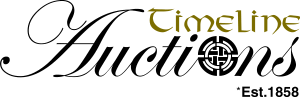Print page | Email lot to a friend
Back to previous pageLOT 0291
Sold for (Inc. bp): £45,000
EARLY DYNASTIC PERIOD II, MID 3RD MILLENNIUM BC
13 1/2" (1.7 kg, 34cm).
A substantial bronze torch bearer depicting a bull or calf standing with straight legs firmly placed, head drawn back, crescentic horns with transverse ribbing, tail extending to the ground; on its back a standing nude female with arms bent and hands cupping the breasts, dressed and plaited hair; above, a balustered stem with three-arm finial forming a cage support.
PROVENANCE:
From the private collection of a North West London lady; previously with a central London gallery; formerly acquired before 1990; this lot has been checked against the Interpol Database of stolen works of art and is accompanied by AIAD certificate number no.157193-10038.
LITERATURE:
See Simpson S.T., Queen of Sheba: Treasures From Ancient Yemen, The British Museum Press, London, 2002, item 297, for a stand with bowl; see Muscarella, O.W., Bronze and Iron: Ancient Near Eastern Artifacts in The Metropolitan Museum of Art, The Metropolitan Museum Museum of Art, New York, 1988, pp.334-335, for objects of a similar form; see Mahboubian, H., Art and Civilization of Ancient Iran, Mahboubian Gallery, Wiltshire, 2004, pp.17-18, for similar objects; see Amiet, P., Art of the Ancient Near East, New York, 1977; Muscarella, O.W., Bronze and Iron. Ancient Near Eastern Artifacts in the Metropolitan Museum of Art, New York, 1988; Aruz, J., Art of the First Cities. The Third Millennium B.C. from the Mediterranean to the Indus, New York, 2003.
FOOTNOTES:
Stylistically the standing male bronze of Early Dynastic II date now in the Metropolitan Museum of Art (accession 55.142) bears a strong facial resemblance to this figure with its bulging eyes and slit mouth below a sharp triangular nose (Aruz item 38). Likewise, the figure of an ibex depicted on a vessel stand (Aruz item 40) of the same period shows a similar treatment of the animal's limbs where the feet are splayed and the joints are modelled as bulbs. The bull and human figure were cast as separate pieces which were later joined with solder made from ground copper salts (see Aruz p.79). By convention, religious persons were usually depicted naked in the art of this period (Aruz, p.79-80) and it seems likely that the piece depicts a scene from myth, or from some ritual enactment thereof.
This figure likely functioned as temple attendant, holding aloft a bowl of incense, a lamp or other form of offering.





